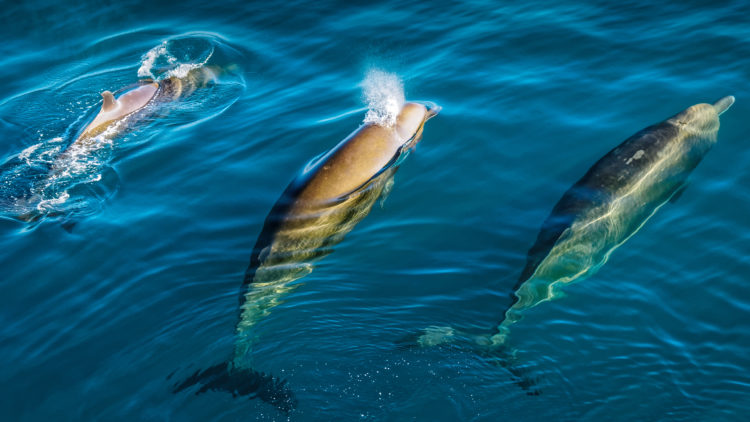Distant navy sonar affects the behaviour of whales

Sonar from naval ships can severely disrupt the behaviour of northern bottlenose whales over distances never previously tested, according to new research from an international team led by the universities of St Andrews and Iceland.
Using animal-attached sensors and deep-ocean acoustic listening devices, scientists found that military sonar sounds caused the whales to stop feeding, swim away from the source of the noise and go into a deep dive.
The new study, published today (Wednesday 20 March 2019) in Proceedings of the Royal Society B, tested specifically for the effects of received sound level and source-to-whale distance on their behavioural responses, and observed that these beaked whales consistently react at low amplitudes of sonar compared to other cetaceans regardless of their distance to the sound source.
The research was led by Professor Patrick Miller of the University of St Andrews and Dr Paul Wensveen of the University of Iceland and involved a large team of scientists and engineers as part of the 3S (Sea Mammals, Sonar, Safety) international research project.
Beaked whales, which include the northern bottlenose whale, are the second largest family of cetaceans in terms of numbers of species. Research on these elusive animals has increased due to their overrepresentation in unusual mass strandings during naval sonar exercises, but their extreme diving behaviour and preference for offshore waters means that they remain poorly understood.
This lack of scientific knowledge is highlighted by the occasional, unexplained occurrences of atypical mass stranding events of beaked whales, such as occurred in the summer of 2018 in Iceland, Scotland, Ireland and Norway. Surprisingly, beaked whales inhabit areas that are frequently used by navies for sonar training and testing. Studies in these areas indicate that animals respond less to sonar from distant naval ships compared to experimental sonar sources much closer, even though the transmitted level from the distant naval ships was so high that the sound received by the animal was still quite loud.
The study tests were conducted near Jan Mayen, an island north of Iceland, in an area of the Arctic which still has relatively little noise pollution. Twelve northern bottlenose whales were tagged with either high-resolution data loggers or satellite-linked tags, and then exposed to sonar sounds in three experiments. In addition, responses of other bottlenose whale groups in the area were monitored using a deep-ocean listening device.
Professor Miller said: “All tagged whales stopped feeding, and individuals started swimming away from the exposure site for several hours when a certain sound level was reached, regardless of their proximity to the source – up to 28 kilometres away.
“One of the whales immediately responded by diving to a depth of 1.6 kilometres that lasted 130 minutes, which, to the best of our knowledge, is the longest dive recorded for this species of whale. The data from the listening device indicated a large-scale response by animals in the exposed area.
“We used a sound source that is smaller than a typical operational naval sonar, so the concern is that the distances at which animals respond in the wild to real navy sonars may be significantly greater.”
Dr Wensveen said: “Within the context of what is known about beaked whales, our results suggest that the relative pristineness of the environment might be an important factor in how these sensitive animals respond to sonar sounds. A lack of frequent or predictable exposures might mean fewer opportunities for the animals to learn that sonar signals pose lower risk when they come from far away.”
Northern bottlenose whales in a pristine environment respond strongly to close and distant navy sonar signals is published by Proceedings of the Royal Society B.
Please ensure that the paper’s DOI (doi/10.1098/rspb.2018.2592) is included in all online stories and that Proceedings of the Royal Society B is credited as the source.
Image credit © Christian Harboe-Hansen
Issued by the University of St Andrews Communications Office.